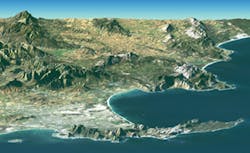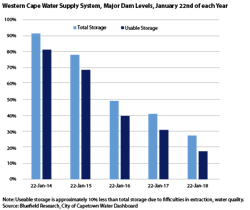The prediction for Day Zero – when water will be switched off in Cape Town – may have been pushed back but it’s still only months away. How did a major city in the modern era reach this desperate stage and what solutions will be required to secure water supplies in the future?
The looming threat of ‘Day Zero’ in Cape Town – the predicted day when taps will be shut off across the city – has set the alarm bells ringing around the world.
It has raised the question of how a major city in a modern era could infact run out of water – a service that has historically been taken for granted globally.
Day Zero had originally been moved forward to April 12th due to a drop in dam levels. However, described by officials as a “moving target”, this was then moved back to May 11, before being moved to June 4 and, at the time of going to print, July 9.
Deputy Mayor Ian Neilson reportedly said that Day Zero has been moved due to “Capetonians reducing their water usage and city’s efforts to bring down consumption. This is very encouraging, but we cannot afford to relax our efforts.”
From February, Capetonians were asked to reduce water consumption down 50 litres of water per person daily in an effort to conserve supplies. Several reasons have contributed to what is being considered the Western Cape’s worst drought in over 100 years.
Cape Town’s population has expanded to over four million people in 2018 from 2.4 million in 1995, yet the city’s dam storage meanwhile has only increased by 15 percent.
Furthermore, water consumption has increased while the region has received below average rainfall. Add a third dry winter into the mix with insufficient conservation efforts and the history leading up to Day Zero becomes clear. Simply put: water demand has outpaced water supply.
International best practise
In a statement, Ian Neilson, deputy mayor previously said: “It is still possible to push back Day Zero if we call stand together now and change our current path.”
Currently a ‘Critical Water Shortages Disaster Plan’ is being drafted for April. Neilson said this “draws on international best practices” and reflects “what other cities around the world have implemented when faced with extreme drought conditions”.
Meanwhile Helen Zille, premier of the Western Cape, outlined plans for Day Zero in a column for the Daily Maverick.
She said: “As we begin the countdown to Day-Zero, the ground has shifted. While we must still do everything possible to prevent this ghastly eventuality (and we still can if EVERYBODY abides by the new water restrictions of 50 litres per person per day), my focus has shifted to overseeing plans for the day the taps run dry – and the weeks that follow.”
Agricultural demand
One of the reasons behind Day Zero being pushed back has been a decline in agricultural water use. At the time of going to print, agricultural water use had dropped from 50 percent of water released from Western Cape dams, down to 30 percent. Importantly, Neilson expects this could drop to less than 10 percent by April, with the sector reaching its seasonal limit of water use.
However, some believe this could be a case of ‘too little, too late’, with high agricultural consumption in the past as one reason why Cape Town is facing Day Zero.
Although the city of Cape Town has been under pressure to implement water restrictions, the “agricultural takings have been less controlled”, according to Will Maize, senior research analyst at Bluefield Research.
Data from the city government shows that while residential water consumption is on target with planned usage, agricultural usage has been above what was planned.
News24 reported that in 2015, nearly 40 percent of Western Cape’s water supply went to agriculture, particularly long-term crops such as fruit and wine, as well as livestock. Although the local tiers of governance - Western Cape province and City of Cape Town - went “above and beyond” to prepare for drought, the system failed at the “level of national government”, the report said.
Cape Town resident Julius Steyn, CEO of engineering company GrahamTek says efforts are underway to cut water to farming community but that it’s a complicated process.
“Water to agriculture has been cut significantly,” he told WWi magazine. “There are national, long-standing contracts in place with agricultural unions – so it’s not just a matter of cutting off the water to the farming community. Cut backs have happened to the agricultural community, so they are using less water than they would have used in non-drought circumstances. In a sense, the agricultural sector is already suffering so you can’t just go and cut the water off – they have to get their allocated quota.”
Day Zero plan
If the Day Zero eventually is reached, the following would happen.
One week before the six dams providing water to the Western Cape Water Supply System drop to 13.5 percent, a date will be announced when all taps in Cape Town’s residential suburbs will be cut off. This excludes hospitals. From that point, municipal water will only be available at 200 points of distribution (PoDs) across the city, which will be monitored by police and law enforcement.
The maximum allocation will be 25 litres per person per day, distributed on the assumption that an average family comprises four persons. For larger families, proof of additional numbers may be needed through identity documents.
Although the city is hoping that the Day Zero situation will only last three months, Zille warned however that such plans could create a “logistical nightmare”, suggesting that if every family sends one person to fetch the water allocation, there would be 5000 people at every POD daily.
City executive mayor Patricia de Lille has previously said that these sites would be extended or include 24-hour operations to cater to such crowds. Furthermore, people would have to carry 100 litres of their water allocation by hand – practically impossible - meaning the provision will have to be made for transport.
Political pressure
With questions being raised as to how the situation is being handled by local authorities, it’s important to note the political situation in the region.
The Western Cape is the only province in the country run by the Democratic Alliance, the official opposition party. Meanwhile, South Africa’s ruling party, the African National Congress (ANC) controls the rest of the country, including the National Department of Water and Sanitation (NDWS), which maintains regulatory control over agricultural water use.
Meanwhile, the city has made good progress with reducing water losses. In total, from 2012 pressure management and pipe replacement efforts have provided Cape Town an estimated 54,400 m3/day – a 7.1 percent supply boost under normal conditions. “The city has been successful with its pressure management improvements so is understandably dismayed at being dragged through the mud in the current situation,” says Maize.
Desalination plans
Meanwhile, GrahamTek has built a desalination plant to provide emergency supply during Day Zero.
The US$2.1 million plant has already been built, using reverse osmosis membrane technology, and will be able to provide between 2500 m3/day and 12,500 m3/day of potable water. The company is in the advanced stages of negotiation with authorities to agree a location.
CEO Steyn says: “Day Zero will have a huge economic impact on businesses, with staff potentially having to take two to three hours per day off work to collected their allocated 25 litres.
“Our solution is two-fold: it will provide local businesses with water, as well as staff for their families, to avoid disrupting the working day.”
The company has historically provided utility-scale desalination projects with 80 percent of its project pipeline outside of South Africa. For this latest development, it has come up with a financial agreement for local businesses to enable it to provide the scaled down operation.
Commenting on the wider reasons for the drought and Day Zero situation in Cape Town, Steyn said it’s a question of “political will, not the intelligence involved or available capability”.
Several ideas have been discussed to provide emergency water supplies during the crisis. A combination of groundwater extraction and small-scale desalination is expected to provide between 120 million to 150 million litres per day.
Zille added: “As the drought is likely to persist, we will have to go for large-scale desalination in the years ahead, and we are grateful to all those entrepreneurs and consortia who have come forward to make proposals in this regard. A feasibility study for a $1.1 billion 450,000 m3/day desalination plant for South African utility Eskom concluded in 2016 but the plans have been postponed to after 2025.
It’s a question of political will, not intelligence or capability
“Cape Town was contemplating desalination for a long time but wasn’t willing to pull the trigger due to high costs,” adds Maize.
For the short term, the City of Cape Town lists seven projects to help secure alternative water sources, including four desalination projects (Cape Town harbour, Strandfontein, Monwabisi and V&A Waterfront), two groundwater projects (Cape Flats and Atlantis) and a water reuse project (Zandvliet). However, all of the projects were listed behind schedule, apart from the V&A Waterfront desalination development.
This temporary plant is expected to provide 2,000 m3/day of water and is being constructed on land made available to the city by the V&A Waterfront at no extra cost.
Moving forward
Maaike Feltmann, is the programme manager at the Netherlands Water Partnership (NWP), which has helped to facilitate cooperation between the Dutch and South African governments, as well as advising on a water master plan for the region.
Commenting on the Day Zero situation, she told WWi magazine: “It’s a political issue but I think the solution won’t be on the political level but more with businesses in the private sector who are going to provide water for themselves, as was seen during the energy crisis,” she says.
One of the challenges during Day Zero will be the class differences in the region, according to Maaike.
“The difficulty in this situation will be the difference between the poor and rich,” she adds. “Water is such a basic need and there will be solutions for people who can pay for it but people who don’t have the money to provide for themselves will have a hard time”.
Commenting on the potential for international collaboration and solutions, the programme manager adds that “the City of Cape Town is overloaded with offers and suggestions from abroad, so it’s a very long process”. She says: “On a B2B level, there are organisations working together to see how they can come up with decentralised water supply systems.”
While decentralised solutions may appease water demand in the short-term, the prediction for the Day Zero situation has reaffirmed the need for diversified water supplies.
“Long-term planning processes require re-thinking amidst an increasingly volatile water cycle,” adds Bluefield Research’s Maize. “Designing resilient water supply systems requires diversification of water supply sources; augmenting surface and ground water supplies with desalination, and even more-so, water reuse. It is also important that regulators – from national to municipal or city level, align policies to ensure that conservation efforts are fair, equitable, and apolitical.”
Tom Freyberg is chief editor of WWI magazine.
11 cities most likely to run out of drinking water like Cape Town
Cape Town is just the tip of the iceberg, according to the BBC, which compiled a list of 11 other cities which they said are most likely to run out of water.
- São Paulo, Brazil: although a water crisis was classed as “finished” in 2016, in January 2017 the city’s main reserves were 15 percent below expected for the period.
- Bangalore, India: the city’s antiquated plumbing needs an “urgent upheaval”, the BBC said. Half of the water supply is lost to waste.
- Beijing, China: 40 percent of the city’s surface water has been classed as polluted to the point of not being useful for agriculture or industrial use.
- Cairo, Egypt: the UN estimates a critical water shortage in the country by 2025.
- Jakarta, Indonesia: with less than half the city’s 10 million residents lacking access to piped water, the illegal digging of wells is rife.
- Moscow, Russia: 25 percent of the world’s fresh water reserves are in Russia but the country is plagued by pollution following the industrial legacy of the Soviet era.
- Istanbul, Turkey: the city’s reservoir levels declined to less than 30 percent of capacity at the beginning of 2014.
- Mexico City: the city imports as much as 40 percent of its water from distant sources and lacks large-scale water reuse programmes.
- London, England: the city is pushing close to capacity and is likely to have supply problems by 2025 and “serious shortages” by 2040, according to the Greater London Authority.
- Tokyo, Japan: home to 30 million, Tokyo has a water system that depends 70 percent on surface water and rainfall is concentrated during the just four months of the year.
- Miami, US: water from the Atlantic Ocean has contaminated the Biscayne Aquifer, the city’s main source of fresh water.






